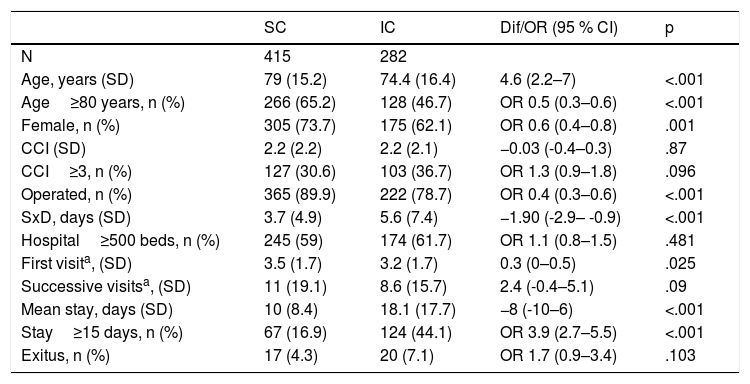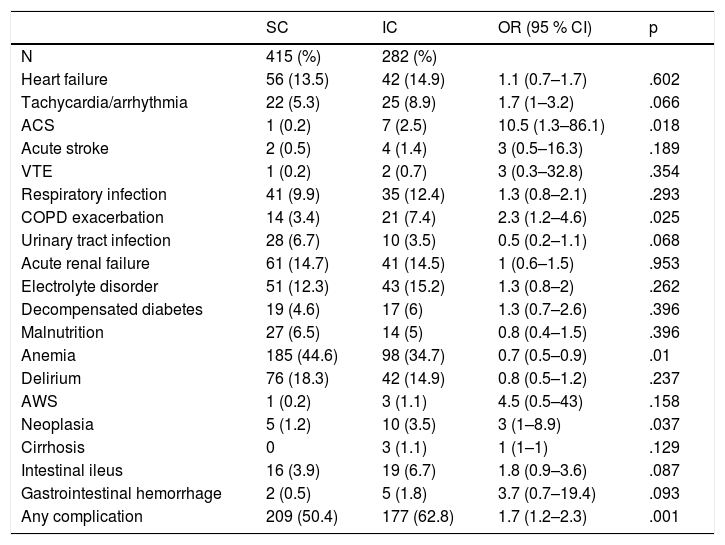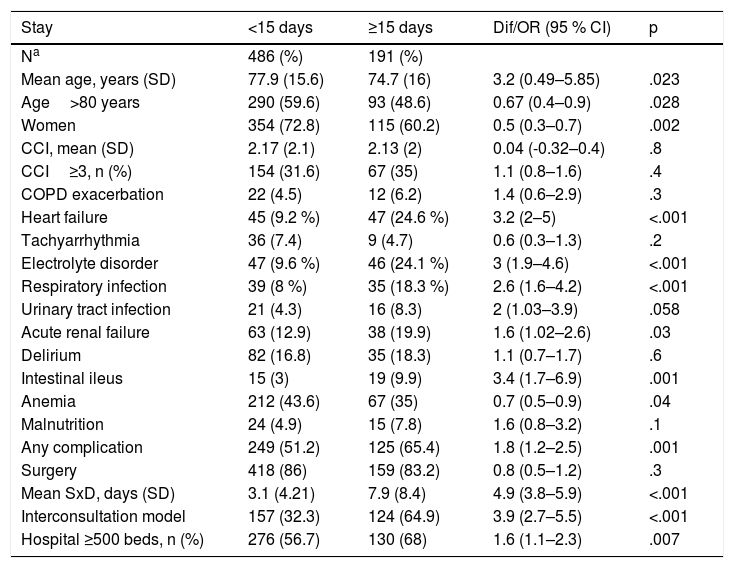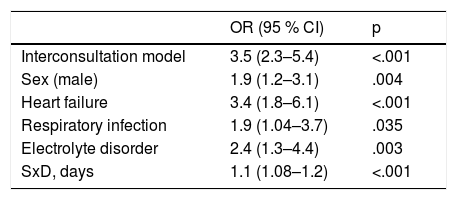Hospitalized surgical patients are increasing in medical complexity, thereby increasing the need for support by internal medicine departments. This support is provided through interconsultations, which present problems that have resulted in the development of shared care (SC). Our objective was to compare the healthcare results achieved by the SC and interconsultation models in orthopaedic surgery and trauma (OTS).
Materials and MethodsWe conducted an observational, prospective, multicentre study of patients hospitalized for emergency OTS recorded in the REINA-SEMI registry, treated by internal medicine departments through interconsultation or SC. We recorded the demographic characteristics, comorbidity, medical complications, hospital stay and mortality.
ResultsThe study included 697 patients, 415 with SC and 282 with interconsultations. The SC patients were older (78.9 vs. 74.3; p<.001) underwent more operations (89.9 vs. 78.7 %; p<.001), had fewer medical complications (50.4 vs. 62.8 %; p<.001) and had shorter hospital stays (10 vs. 18 days; p<.001), with no differences in comorbidity or mortality. The following independent factors were associated with stays longer than 15 days: heart failure (OR 3.4; 95 % CI 1.8–6.1; p<.001), the male sex (OR 1.9; 95 % CI 1.2–3.1; p=.004), electrolyte disorder (OR 2.4; 95 % CI 1.3–4.4; p=.003), respiratory infection (OR 1.9; 95 % CI 1.04–3.7; p=.035), surgical delay (OR 1.1; 95 % CI 1.08–1.2; p<.001) and treatment using the interconsultation on demand model (OR 3.5; 95 % CI 2.3–5.4; p<.001).
ConclusionsSC offers better healthcare results than interconsultations for patients hospitalized for emergency OTS.
Los enfermos quirúrgicos hospitalizados están aumentando su complejidad médica, incrementando la necesidad de apoyo por Medicina Interna. Este apoyo se realiza mediante la interconsulta, la cual presenta problemas que han inducido el desarrollo de la asistencia compartida (AC). Nuestro objetivo es comparar los resultados asistenciales alcanzados por los modelos de interconsulta y AC en Cirugía Ortopédica y Traumatología (COT).
Material y métodoEstudio observacional, prospectivo, multicéntrico, de los enfermos hospitalizados de urgencia en COT recogidos en el registro REINA-SEMI, atendidos por Medicina Interna mediante interconsulta o AC. Se registraron las características demográficas, comorbilidad, complicaciones médicas, estancia hospitalaria y mortalidad.
ResultadosSe incluyeron 697 pacientes, 415 con AC y 282 con interconsulta. Los de AC tenían más edad (78,9 vs 74,3; p<0,001), se operaron más (89,9 vs 78.7%; p<0,001), tuvieron menos complicaciones médicas (50,4 vs 62.8%; p<0,001) y su estancia hospitalaria fue menor (10 vs 18 días; p<0,001), sin diferencias en la comorbilidad ni mortalidad. Los factores independientes asociados a estancia superior a 15 días fueron: Insuficiencia cardiaca (OR 3,4; IC 95% 1,8-6,1; p<0,001), sexo (hombre) (OR 1,9; IC 95% 1,2-3,1; p=0,004), trastorno electrolítico (OR 2,4; IC 95% 1,3-4,4; p=0,003), infección respiratoria (OR 1,9; IC 95% 1,04-3,7; p=0,035), demora quirúrgica (OR 1,1; IC 95% 1,08-1,2; p<0,001) y ser atendido mediante el modelo de interconsulta a demanda (OR 3,5; IC 95% 2,3-5,4; p<0,001).
ConclusionesLa asistencia compartida ofrece mejores resultados asistenciales que las interconsultas en pacientes ingresados de urgencia en COT.
Article
Diríjase desde aquí a la web de la >>>FESEMI<<< e inicie sesión mediante el formulario que se encuentra en la barra superior, pulsando sobre el candado.

Una vez autentificado, en la misma web de FESEMI, en el menú superior, elija la opción deseada.

>>>FESEMI<<<









